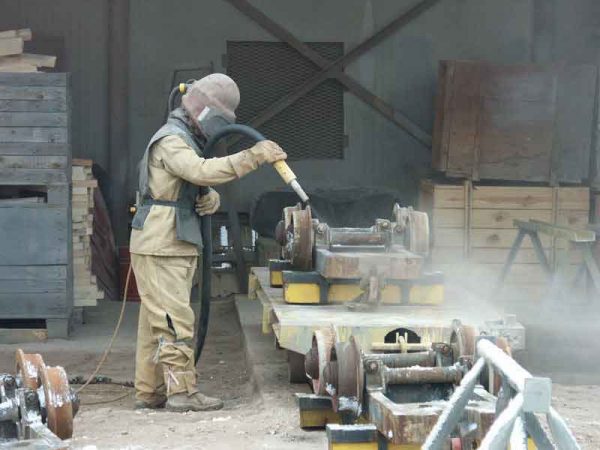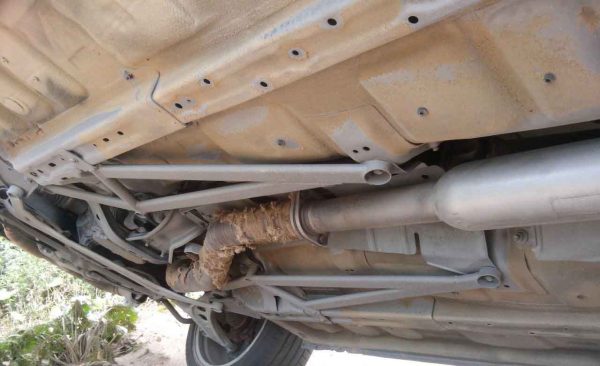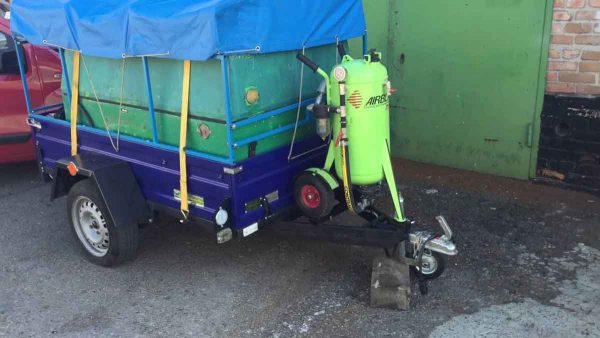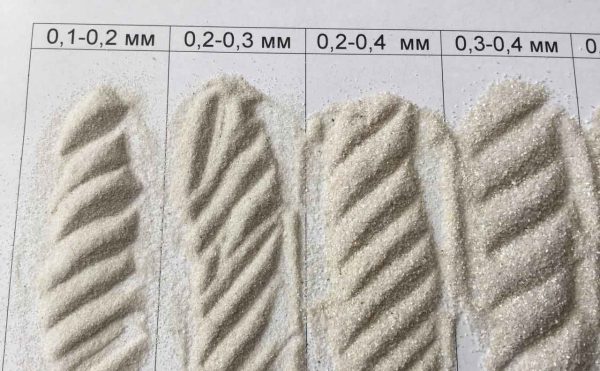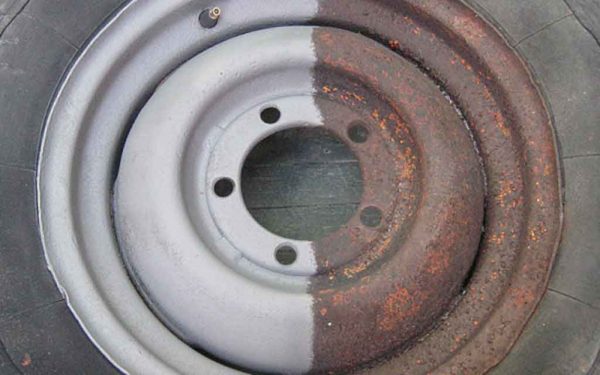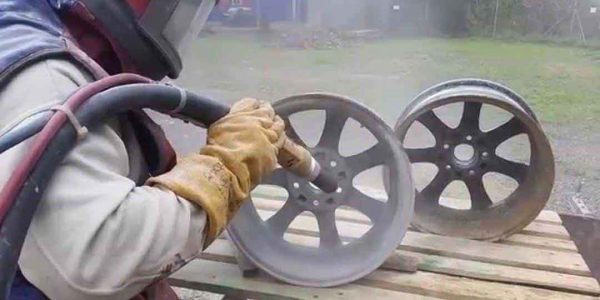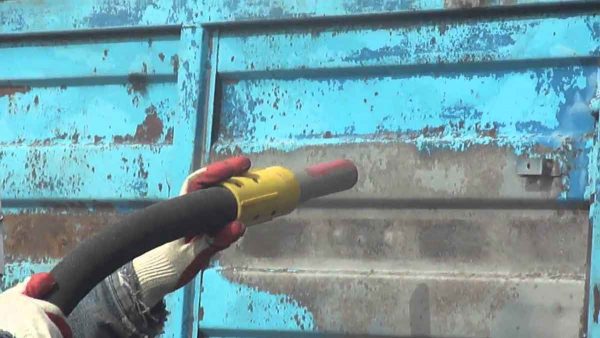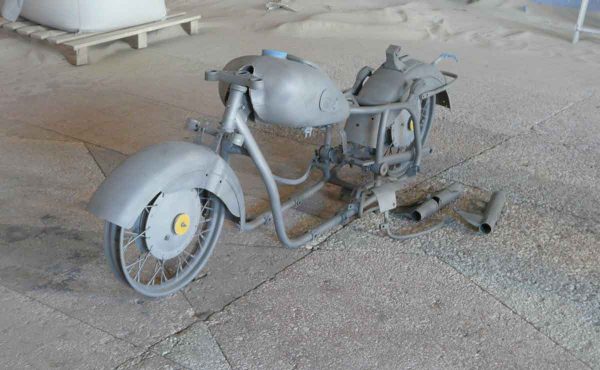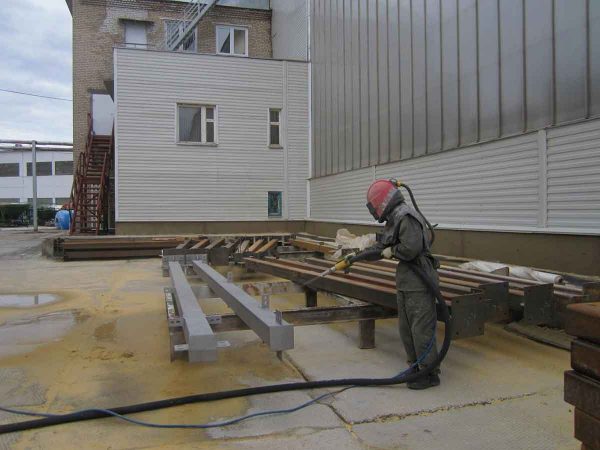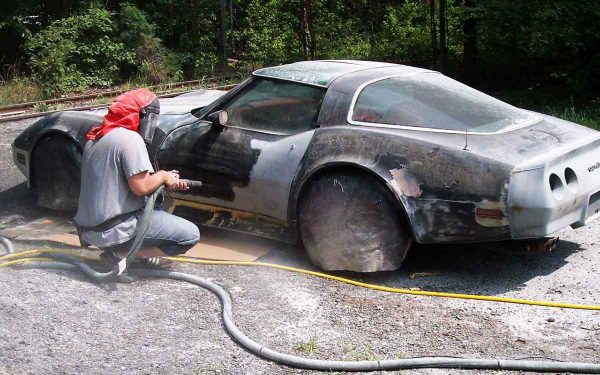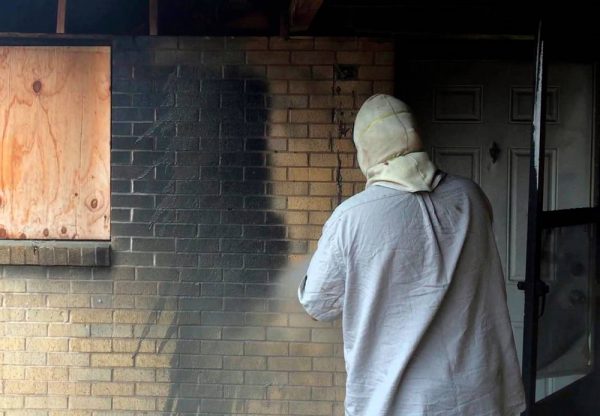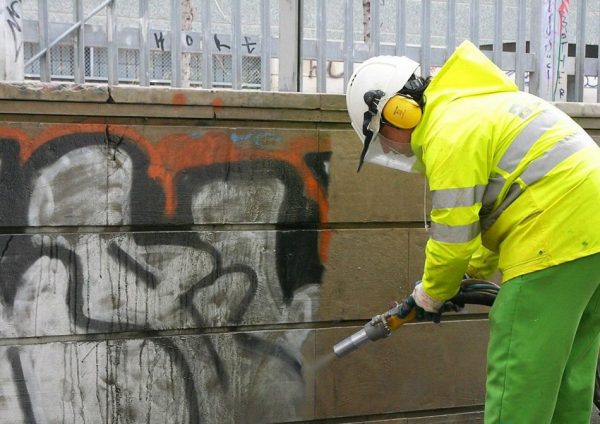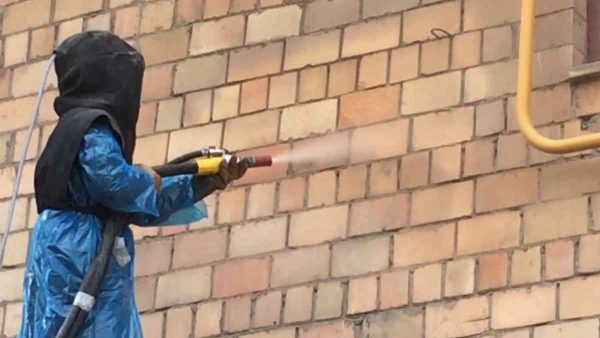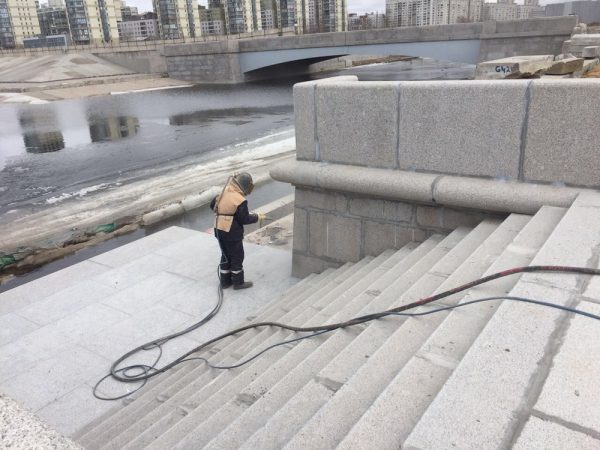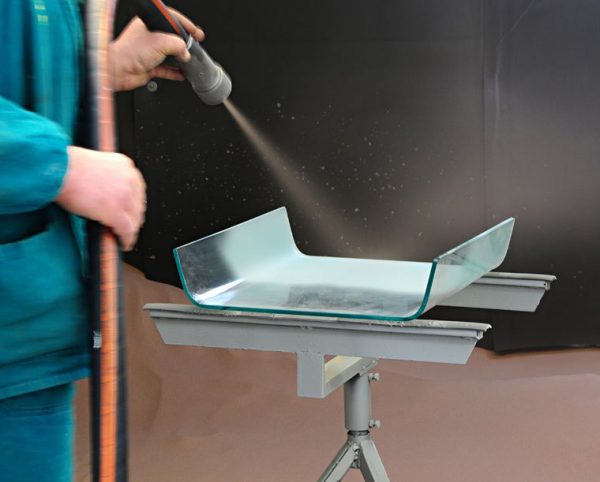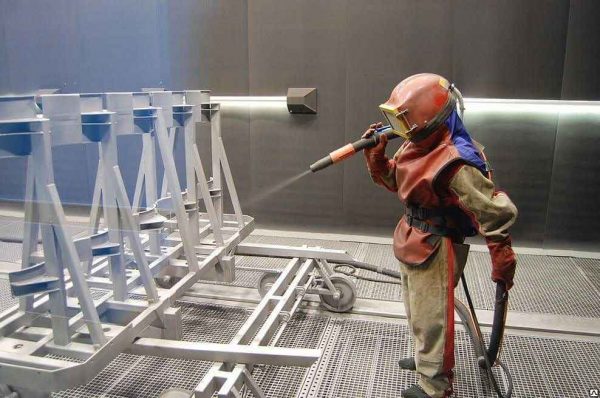Sandblasting is an effective technology for cleaning metal and other surfaces from various types of contaminants. Usually it is carried out before applying a new paintwork (LPC) on the car body, as well as to remove rust from metal structures, although there are other areas of application of the technique.
- The essence and purpose of technology
- Types of sandblasting
- Types of Sandblasting Equipment
- Varieties of abrasive materials
- Pros and Cons of Processing
- General Processing Rules
- Sandblasting of the body and body elements
- Sandblasting of car components and assemblies
- Sandblasting disc
- Sandblasting frames and trailers
- Sandblast motorcycle parts
- Cleaning metal from corrosion
- LCP removal
- The use of sandblasting in domestic conditions
- Cleaning after a fire
- Building restoration
- Facade cleaning and graffiti removal
- Brick cleaning
- Granite restoration
- Drawing on glass and mirrors
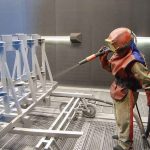
The essence and purpose of technology
When performing sandblasting, products, materials are cleaned of dirt, dust, grease, molding compounds and coatings using abrasive substances. The principle of the technique is based on the interaction of the air-abrasive mixture supplied under pressure with the surface of the substrate, which leads to the detachment of the plaque located on top.
To “disperse” the abrasive, special equipment is used - a sandblasting device with a compressor, which creates the necessary pressure in the system (usually 6-9 atmospheres). After sand or other abrasive is captured by the air stream and thrown onto the work surface. The particle velocity is very high: on average, it is 720 m / s.
Sandblasting allows you to clean the metal efficiently, prepare it for painting or any other type of finishing work. Moreover, the top layer of the product becomes a little rough, so the adhesion to the paintwork increases significantly, the service life increases.
The coating will be as durable as possible after deep sandblasting, which removes even hidden foci of corrosion and other base defects. In the industry, sandblasting is also used to get rid of dirt, grease stains, to improve the reliability of welding.
to contents ↑Types of sandblasting
Depending on the depth and intensity of processing, such degrees of purification of materials are distinguished:
- Easy. Only large traces of rust, as well as scale and flaking paint, are removed. In terms of effectiveness, it resembles manual processing with a metal brush.
- Partial (selective). It is processed no more than 5-10% of the surface.
- Medium. Upon visual contact, the product looks clean, but hidden traces of corrosion may persist (they make up less than 10% of the area).
- Deep All dirt and rust are completely removed from the surface. The consumption of abrasive substance during this treatment is significant.
There is another classification of metal cleaning levels:
- removing - removes the base from dirt, old paint, but part of the rough layers may remain provided that they do not interfere with the quality of subsequent coatings;
- fine - there is no pollution, there is moderate roughness;
- commercial - any contamination, grease, scale, there are no traces of pitting, small chips, strips are possible.
Types of Sandblasting Equipment
There are two types of devices for abrasive cleaning of materials on the market. Mobile units are compact in size, so they can easily be moved to any place by one person. Typically, work requires strong protective equipment, because the air in the apparatus area is very dusty and becomes dangerous to human health.
Stationary automatic cameras are enclosed spaces with the necessary equipment located inside. Such devices are safe for the operator, because he only immerses his hands through special tight gloves. Due to the presence of a special system, the abrasive in most devices can be reused. The dimensions of the processed products are limited by the dimensions of the cameras: most often they include only small parts.
According to the principle of operation, equipment for sandblasting also varies. Here are the main categories of sandblasting:
- Pressure A feature of the work is the method of supplying abrasive material - it goes through one hose with air, and not separately. The performance of such devices is high, but highly dependent on the compressor power. It is best to use pressure sandblasting machines to clean large areas.
- Injection. Air and abrasive come in different arms, so the nozzle is divided into two channels - air and abrasive. The productivity of such plants is much lower, therefore they are usually used for domestic purposes, for drawing drawings, for decorative processing or to roughen the surface.
- Vacuum They are a subtype of pressure vessels, but have some design features. After being ejected onto the surface to be treated, the abrasive is sucked in by vacuum. Such units are used much less often than others due to low productivity.
Varieties of abrasive materials
The very first abrasive for surface treatment was sand: from it the machines got their name. Now metal is cleaned with sand and other, more modern and efficient materials. They differ in the following physical characteristics:
- hardness - determines the intensity of processing and its speed;
- particle size - coarse materials have a higher impact force;
- homogeneity - a uniform surface treatment is provided only by particles of approximately the same size;
- shape - round elements remove contaminants in direct contact with the surface, elongated ones act by the force of friction, grain-like ones give a polishing effect.
Abrasive materials are also classified by origin:
- Natural. The group includes different types of sand - river, quartz, desert, sea. Now their use is limited, since there are many more effective analogues.
- Vegetable. These are different bones, husks, other products of plant processing. They act very gently and are most often used to clean delicate surfaces.
- Industrial. They can be based on metal, products of its processing or non-metal. The most famous abrasive of this group is steel shot, which can be used repeatedly. Of non-metallic abrasives, glass grain and crushed plastic are most often used, of waste - slag, corundum.
Pros and Cons of Processing
Sandblasting has several advantages:
- quick cleaning of surfaces, especially in comparison with manual exposure;
- excellent quality of work - the air-abrasive mixture guarantees the removal of absolutely all types of dirt and old coatings;
- the ability to independently adjust the type of cleaning - this property is achieved when the operating pressure of the installation changes;
- no harm to metal - the thickness of the product does not change, as well as other parameters;
- universality - sandblasting is suitable for almost all metal products, as well as for glass, wood, concrete and a number of other materials.
Disadvantages of such processing are also noted. If the installation is industrial, the operator needs to be trained. For small household devices, this item can be skipped, but familiarization with security measures is still required.
The price of good devices is quite high, especially when it comes to stationary cameras. The use of sand can be hazardous to health, because the smallest particles of sand dust can settle in the lungs and cause serious illness. Instead of sand, it is better to use more modern abrasives, but they are much more expensive.
to contents ↑General Processing Rules
You can get a really high-quality processing result only when choosing good equipment, consumables and components. The abrasive material should be ideally suited for a particular type of work, otherwise the surface will not be cleaned enough, or it will be scratched.
The higher the productivity of the sandblasting compressor, the faster the cleaning will occur, and the efficiency will be greater. Installations with large diameter hoses must be selected to reduce pressure loss. Couplings, connectors must exactly match the diameters of the sleeves. You should also pay attention to the quality of the nozzle - the most durable are made from boron carbide, however, they cost much higher than others.
to contents ↑Sandblasting of the body and body elements
Bodywork - the most popular type of work with a sandblasting machine. With it, you can clean the surface of old dirt, remove traces of scale, paint, rust. Also, sandblasting helps to assess the degree of metal damage by corrosion and choose the best way to restore it.
Sandblasting of car components and assemblies
Cleaning the surface of important components, joints and machine parts using sandblasting is considered the most effective way to protect them from damage. In addition to removing rust, stains and old coatings, processing helps to improve the adhesion of the metal with a primer, paint, varnish.
Sandblasting disc
Sandblasting rims is a popular service in car repair shops. It helps to remove all contaminants from the base, including old and high density, removes traces of rust and paint, as a result of which the base becomes suitable for restoration. With the help of sandblasting, it is possible to rid the discs of the primary corrosive attack (scale), hard-to-remove pitting rust, increase strength and appearance. After applying sandblasting and applying powder paint, the disks will look like new.
to contents ↑Sandblasting frames and trailers
Before restoration and painting of frames, trailers, abrasive treatment is mandatory, which in the future will protect the metal from the destructive effect of corrosion. It is especially recommended to clean the sandblast in the presence of such problems:
- pollution caused by high temperatures;
- traces of pitting or other rust;
- mold, fungus;
- oily deposits, petrochemical residues;
- anticorrosion coating that started to break down.
Sandblast motorcycle parts
Using sandblasting, you can easily clean various motorcycle parts from any contaminants. Most often, when repairing equipment, they carry out sandblasting of such units and elements:
- frame;
- wings;
- pendulum;
- side covers;
- tank;
- muffler;
- calipers;
- disks;
- steering wheel;
- stroller, stroller frame;
- traverse.
Cleaning metal from corrosion
At home, the disposal of metal from rust is most often carried out using chemicals - the so-called converters. But the efficiency of their work remains at a low level if the pockets of corrosion are multiple or deep. With hidden elements, they are easy to miss. Usually only the top layer of rust is removed, and the corrosion process continues to develop.
to contents ↑Sandblasting removes even deep damage of metal by rust, and is suitable for any nodes, parts, surfaces. It is always advisable to subject the product to such a treatment before applying a new protective or decorative coating.
LCP removal
To clean the varnish, paint from small bases, you can use a metal brush or sandpaper. But manual cleaning of the old paintwork on significant surface areas will be difficult and time consuming. It is better to use sandblasting technology, which has several advantages:
- high speed - in a day really remove paint on 100 square meters of surface or more;
- universality - you can get rid of any type of paintwork;
- grinding and matting - in addition to removing old paint, varnish, giving the metal cleanliness to shine, microscopic grooves are created on the surface, which enhances adhesion with a new layer of paint;
- ideal result - thanks to sandblasting it is possible to remove the remains of paints and varnishes even in hard-to-reach places.
The use of sandblasting in domestic conditions
In specialized stores, various models of sandblasting machines are presented, many of which are well suited for domestic use. Especially popular are the devices of the Karcher brand, which are suitable for processing any area. Some craftsmen call sandblasting “front guns”, because they are often used in the course of restoration of buildings.
At home, with the help of sandblasting, you can clean both smooth metal substrates and volumetric structures made of different materials. Mobile devices that are compact in size and easily move around the territory are best suited for everyday life. One person can control such a device, he will not need assistants.
In most modern devices, not only quartz sand, but also other materials are used as an abrasive. It is important that the size of the fraction corresponds to the diameter of the nozzle, because the particles must pass freely through the nozzle opening.
to contents ↑Cleaning after a fire
Processing of metal that has been damaged by fire consists in removing carbon deposits from the surface of the products. This type of contamination is formed from the action of high temperature and is poorly cleaned by manual methods. But sandblasting quickly cleans dirt, grease, acting on the metal with a stream of air-abrasive mixture.
to contents ↑Building restoration
Sandblasting during the restoration of old and damaged buildings, buildings are very in demand. Peskostruy allows you to extend the life of houses, used in the restoration of historical objects, is used at certain stages of the construction of new buildings.
Facade cleaning and graffiti removal
Removing walls of buildings from inscriptions and pollution can also be carried out using sandblasting. Painting over drawings most often does not give the desired result; moreover, the facade will have to be painted completely to maintain attractiveness. But with the help of sandblasting, you can quickly and without unnecessary costs to remove all the inscriptions and dirt from the house, restoring its "appearance".
to contents ↑Brick cleaning
It is also possible to maintain a beautiful appearance of the masonry by sandblasting. It is carried out regularly to get rid of plaque, pollution, darkening. Sandblasting allows you to remove dirt even from seams, grooves and other hard-to-reach areas.
to contents ↑Granite restoration
Granite provides the building with strength and aesthetics, but with time it ages, darkens and requires restoration work. Sandblasting is ideal for restoring the natural beauty of granite. Abrasive particles of a small fraction will return the masonry shine, remove dirt and abrasions, as a result, buildings and structures will look like new.
to contents ↑Drawing on glass and mirrors
The use of special nozzles allows the use of sandblasting units for drawing on glass, mirror surfaces, as well as wooden and metal frames of similar products. With the help of a sandblast, you can remove the old paintwork, give a shine to the surface, and then perform the original decor on it.
Sandblasting products is useful in industry and everyday life. The versatility, versatility, ease of working with sandblasting equipment makes it popular in a variety of activities, especially since the operation of devices does not require special skills and knowledge.

